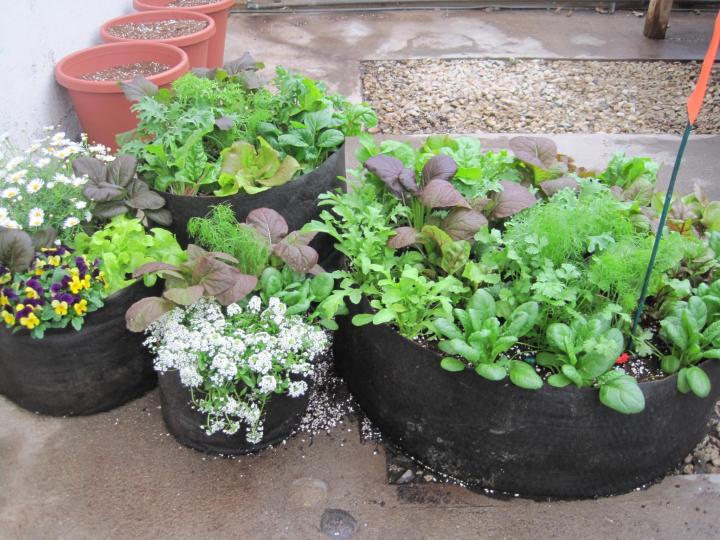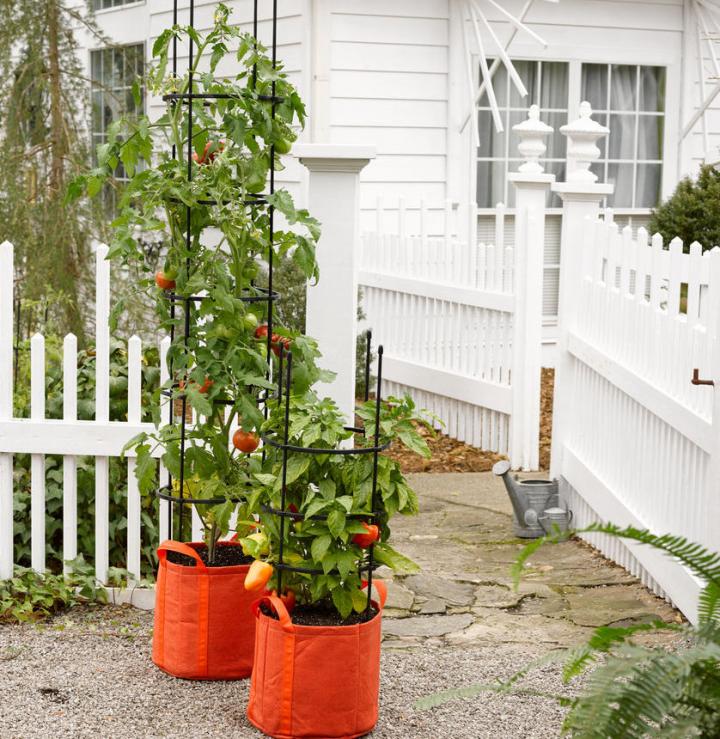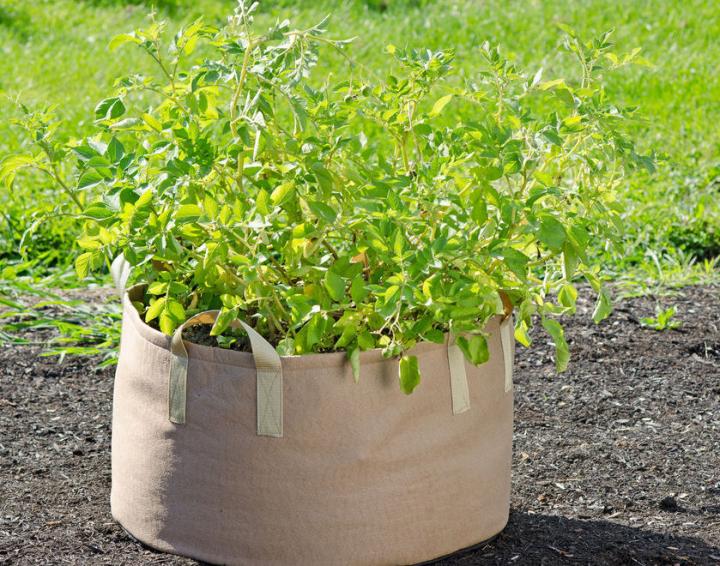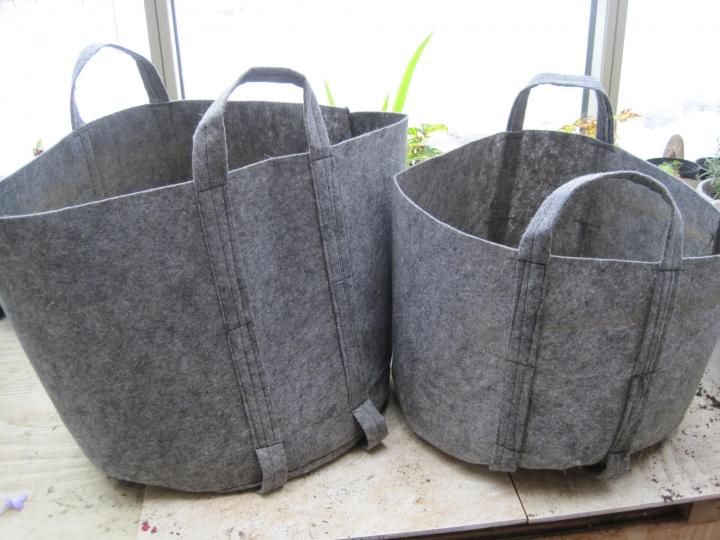If, like me, you resort to using containers to grow some of your plants, try using a grow bag this year. They have some advantages over plastic pots or terra cotta. I was especially interested to learn about “air pruning.” Here’s why and when to use a grow bag and some different types of grow bags.
Grow bags aren’t a new idea. In ancient times, plants were grown in woven baskets and bags. Ancient Egyptians would weave plant baskets and the Greeks used woven containers on their rooftop gardens because they could be easily moved. Many British gardeners have long grow bags as an alternative to planting directly into greenhouse soil.
Today, they are still ideal for growing plants in the greenhouse, but there has been growing interest in using them as an alternative container.
Grow bags are are especially helpful and affordable for growing plants on patios and balconies!

Why Use a Plant Grow Bag?
-
Pots are heavy and difficult to move. Grow bags are lightweight. If you are growing on your balcony or anywhere weight is an issue or will need to move the containers during the growing season, fabric pots weigh practically nothing. It is only the weight of the soil that you have to deal with.
-
They are breathable and drain well. Unlike plastic, the fabric allows air to reach plant roots so the soil won’t get soggy. It is hard to overwater them.
-
They prevent plants from becoming rootbound. When a root reaches the side of the container it comes in contact with drier soil and more air. Instead of circling the pot and eventually strangling the plant, that root stops growing. Called “air pruning,” this encourages the plant to make new roots giving it a robust root system with many small root tips that can take in water and nutrients instead of a few long roots choking it. The plant can put more energy into top growth as well. Many growers swear that the plants in the grow bags do much better than those in plastic pots.
-
Soil is cooler in summer. Black plastic pots heat up in the summer sun. Since the bags can breathe, heat can escape. The felt-like fabric is more insulating than plastic so the soil stays a bit warmer when the weather cools down.
Best Plant for Grow Bags
Grow bags are best for vegetables that do not have deep roots. My favorites include:
- Tomatoes
- Sweet peppers
- Chili peppers
- Zucchini and summer squash
- Cucumbers
- Eggplant
- Potatoes
- Salad greens (lettuce, endive, rocket)
- Basil and some herbs
You’ll plant 2 to 3 plants in a bag in the spring. For salad greens it’s best to cut across the width of the bag and sow in rows.
See our Almanac Grow Guides for information on planting all of the above vegetables.
Choosing a Grow Bag
Be mindful when shopping online for grow bags that all bags are not the same. There are some really cheap ones that are just heavy-duty, black plastic bags—like a contractor’s trash bag. They might be cheap but they offer none of the advantages of a fabric grow bag. Plastic bags do not water well; they retain water and heat which is bad for the soil!
A good grow bag is are constructed from a polypropylene felt-like fabric which is breathable and allows the air pruning. The fabric must be BPA-free and food-safe.
Here are some examples of quality grow bags. (We do not get any payment from Gardener’s Supply Company. We just like their grow bags!)

Gardeners.com Tomato Grow Bags

Gardeners.com Potato Grow Bag
There are many sizes to choose from ranging from small seedling bags to 1,000 gallon raised garden beds. There are specialty grow bags like the 15 gallon potato bag that has a flap near the bottom so you can easily harvest new potatoes without disturbing the whole plant. There are tall skinny ones made for growing trees. You can get square ones to make an instant planting bed. A 4’X4’ square 12 inches deep holds 16 cu ft. or 120 gallons of soil. There are small ones, 4”X5”, with Velcro closures to make removing seedlings for transplanting easier.

Growing Tips
I bought 2 at my local hardware store a few years ago just to try them out and use them every summer to hold extra plants. One year it was sweet potatoes, then pepperoncini, and last year tomatoes.
- All the plants grew just fine though the sweet potatoes could have used a bigger bag. Many of them grew in an L-shape, like they hit the side of the bag and took a right angle turn.
- The compost in the bag shouldn’t get too compact; keep it loose by shaking and kneading it like a pillow.
- Keep in mind that the top of each root ball should be just below the top of the bag.
- Water well and label. Keep the compost moist and feed plants such as aubergine, tomatoes, cucumbers and peppers with a high potash fertilizer when flowers appear.
- Since grow bags are so porous and drain fast, they do need more frequent watering than a plastic container. If you use them indoors be sure to put them on a large saucer to contain any leakage.
- Taller plants (such as tomatoes) need support. Place a cane into the bag and tie the plant to the cane and attach the cane to a frame.
- The good bags last! Many of the bag manufacturers say they last 3 to 4 years but mine are still like new after 3 growing seasons. I dump the soil into my compost pile in the fall, let the bags dry, and fold them up to store inside over the winter. They are pretty rugged and when they aren’t holding a plant they can be used for lugging wood, hauling compost or mulch, or as a harvest basket.
Handy folks can try making their own grow bags from heavy-duty landscape fabric. Be sure to use nylon thread instead of cotton which will deteriorate fast causing your bag to fall apart.
Got a balcony, patio, or rooftop garden? Seee more about growing plants on a sunny patio or balcony!
















